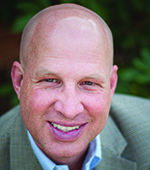By John Chandler
 I am 54 years old and have wonderful news for people who are roughly my age: all things equal, life gets a lot better, and you are about to get happier.
I am 54 years old and have wonderful news for people who are roughly my age: all things equal, life gets a lot better, and you are about to get happier.
This, according to Brookings Institute senior fellow Jonathan Rauch, in an Atlantic cover story, “The Real Roots of Midlife Crisis.” Rauch thinks Gail Sheehy’s famous 1974 book, Passages: Predictable Crises of Adult Life, has it all wrong. Pointing to research in the burgeoning field of “happiness studies,” Rauch says our truest story for middle-aged Americans is not best told as midlife crisis, with its concomitant “irresponsibility, escapism, self-indulgence (think red convertible!), antisocial behavior.” No, there is a better social narrative, fairer and more accurate. It is the “U-curve,” a story not of chaos, diminishment or disruption but of natural transitions toward a new equilibrium.
The U-curve, as charted by Brookings scholars Carol Graham and Milena Nikolova and drawing upon Gallup polls, “shows a clear relationship between age and well-being in the United States.” Simply put, when respondents rate themselves vis-à-vis “the best possible life,” their happiness is highest at age 18, gradually diminishing until about age 47. But from 47 to age 92, self-ratings of happiness climb steadily, often outpacing even the highest teenage happiness markers.
Of course, as with any big trend, there are scores of individual exceptions. But the U-curve has been widely studied among social economists since the 1970s research of Richard Easterlin of USC. David Blanchflower of Dartmouth began to apply this to social economics in the 1990s and found a persistent pattern. “Whatever sets of data you looked at, you got the same things: life satisfaction would decline with age for the first couple of decades of adulthood, bottom out somewhere in the 40s or early 50s, and then, until the very last years, increase with age, often (though not always) reaching a higher level than in young adulthood.” Ask broadly the question, “All things considered, how happy are you with your life as a whole these days?”, and the statistical answer you will get is the happiness U-curve.
Unhappy people often self-deselect from life. Middle age can be burdened with simultaneous stresses of jobs, kids and aging parents. But with shortening life horizons, middle age provides the perfect opportunity for recalibrating one’s values. The smart (happy) people recalibrate toward investing in relationships. They let go of acquisition as the meaning of their lives, and drop unrealistic hopes. They move toward more attainable goals. They put aside unmet aspirations and regrets and move toward the relational virtues of compassion, empathy, equanimity and comfort with uncertainty. It’s a less competitive life, and a more emotionally regulated life. It can also be a more generous and joyful life.
The Baby Boomers who dominate our population, born 1945 to 1964, now range from 51 to 69 years old. Can our Baptist churches speak a word of hope to them — and one based not only on statistical factors, but one based in the hope of the gospel?
If so, then to paraphrase Jesus (badly), come with me, all you young adults who labor and are heavy laden. The 50s and beyond await. Your knees may ache and your hair disappear. But wisdom and peace await you. You are about to be happier.
